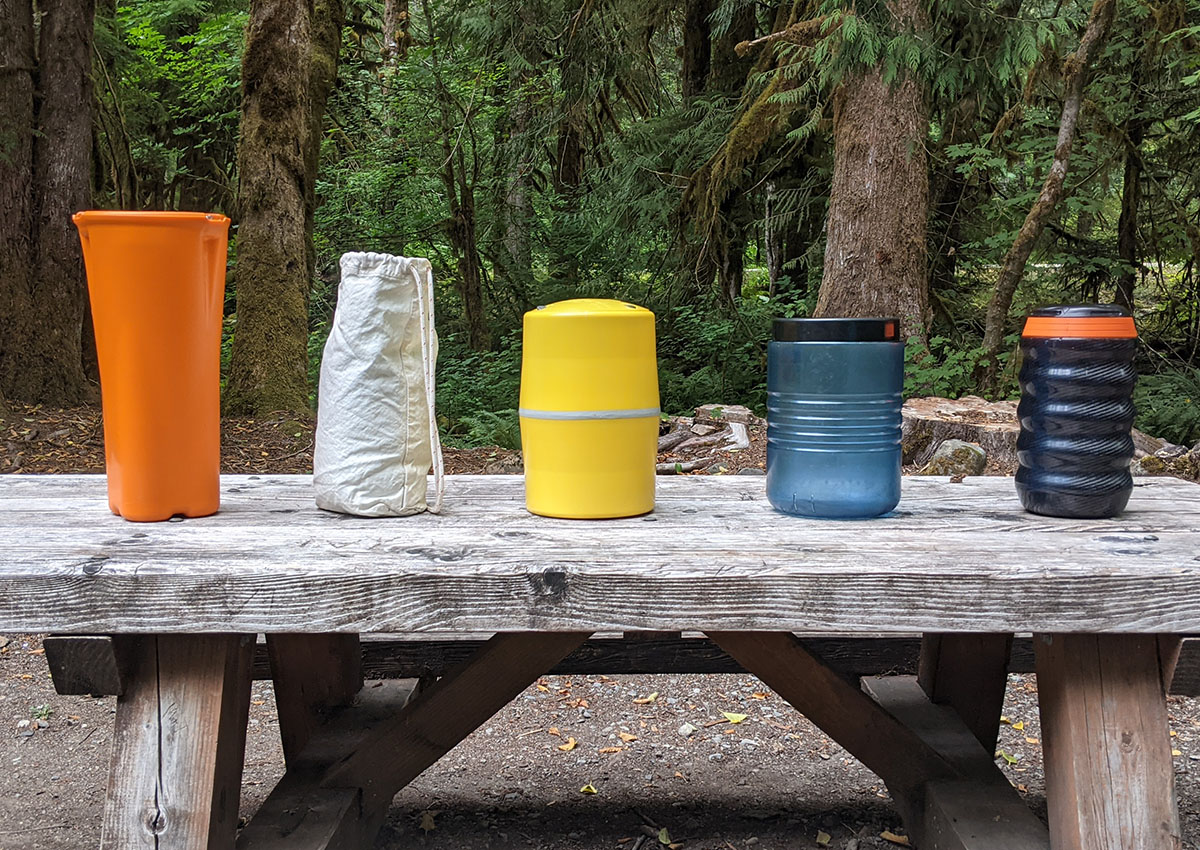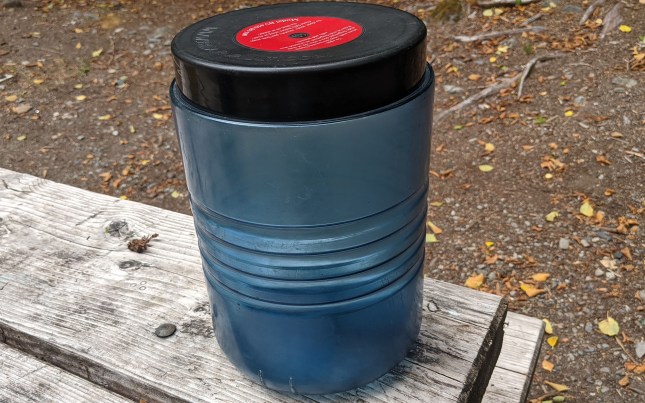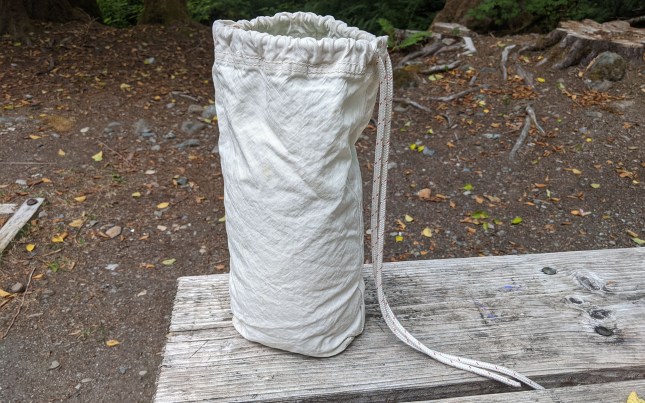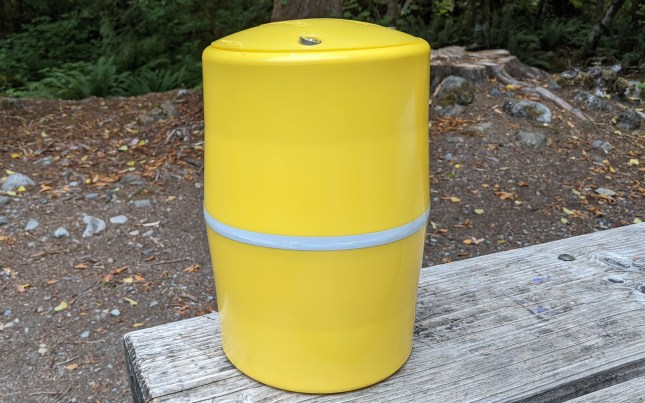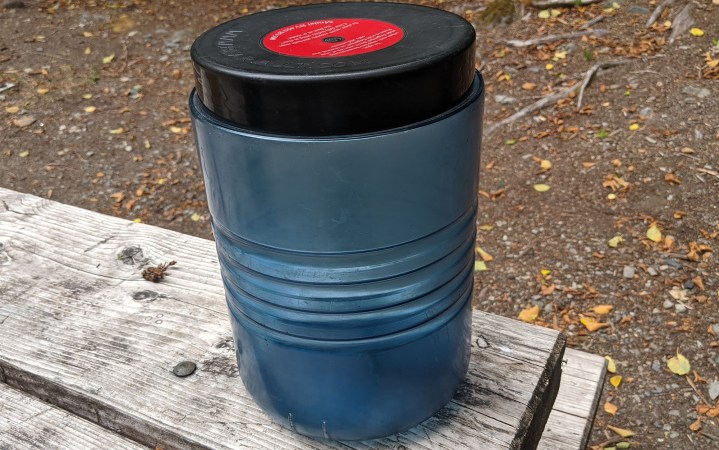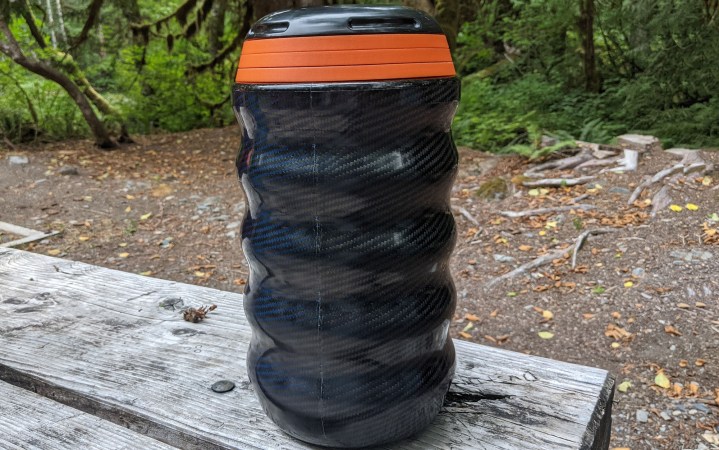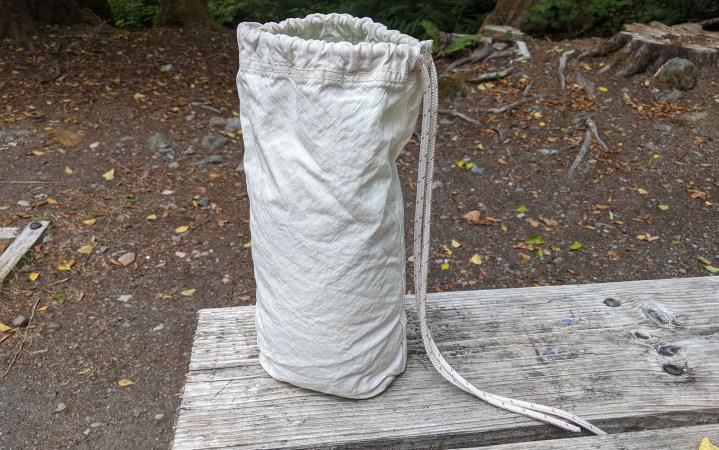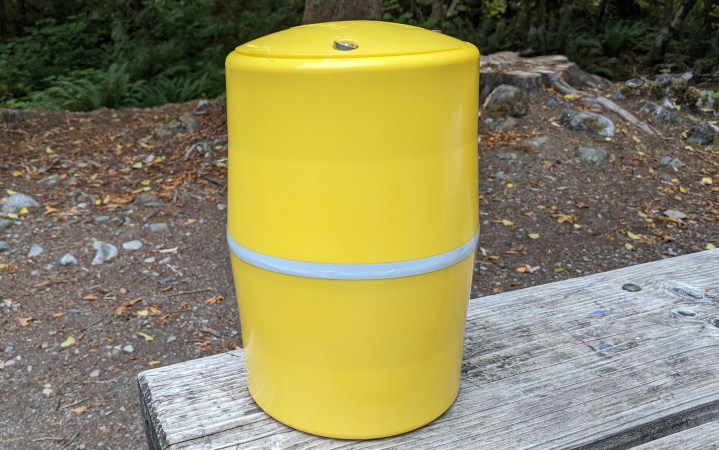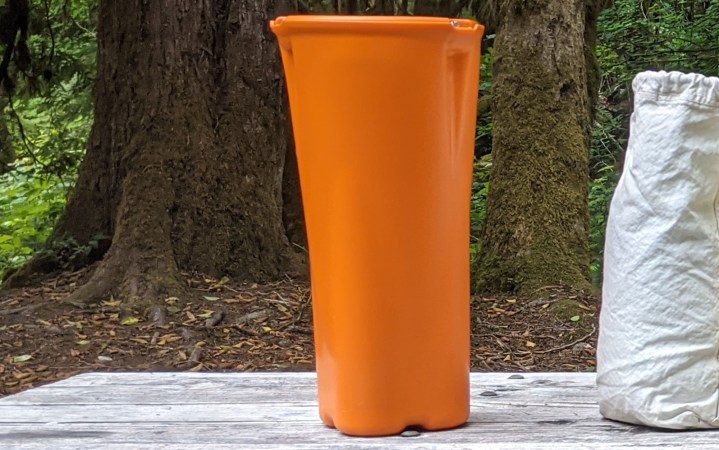We may earn revenue from the products available on this page and participate in affiliate programs. Learn More ›
Whether we like it or not, traveling into bear territory often means carrying a bear canister. These hardshell (and one softshell) containers are tested to withstand bears using the most rigorous testing procedures: actual bears. The sheer strength, might, and ingenuity of bears should be not underestimated, which makes selecting your storage vessel that much more important. Here are my picks for the best bear canisters available for purchase today, all certified by the Interagency Grizzly Bear Committee.
- Best Overall: BearVault
- Best Lightweight: Grubcan Carbon 6.6
- Best Ultralight: Ursack Major
- Most Widely Accepted: Counter Assault Bear Keg
- Best Seat: Frontiersman Insider Bear Safe
How I Chose the Best Bear Canisters
For this story, I only looked at bear canisters approved by the Interagency Grizzly Bear Committee. These cans have been tested by a skilled (and motivated) set of bears at the Grizzly & Wolf Discovery Center. While these testing protocols certify that bear cans are extremely bear resistant, employees at the center are quick to remind you that no bear canister is entirely bearproof. Bears have gotten into bear canisters that have been improperly locked in the past; they have also broken into bear canisters that were properly locked and stored. Never underestimate how smart and persistent bears can be.
Read Next: How Are Bear Cans Tested? They’re Mauled, Stomped, and Chewed by Hungry Grizzlies
While the IGBC is the most widely used agency for approving bear canisters for backcountry use, several parks have their own lists of restrictions. Just because a bear canister has been approved by the IGBC does not mean it is universally allowed everywhere in the backcountry. Before you make a purchase, check that the bear canister you are considering is approved by the relevant land agency. This is especially important in high-use areas like Yosemite National Park, Yellowstone National Park, and the Adirondacks, as the bears here are skilled and accustomed to breaking into your food stash, based on past successes. By properly storing your food, you are not only protecting yourself and your stash, you are also protecting the bears. When the bears in these hot zones become too habituated to sourcing food from backcountry campsites they eventually have to be relocated or killed.
| Bear Canister | IGBC Certified | Weight | Available Capacity | Closure Tools | Difficulty Level | National Park Restrictions?* |
| BearVault | 2022 | 1.75 to 2.5 pounds | 5 liters to 11.5 liters | None | Easy | Allowed everywhere (discouraged in the Adirondacks) |
| Counter Assault Bear Keg | Yes | 3.6 pounds | 11.7 liters | Coin | Average | Allowed everywhere |
| Frontiersman Insider Bear Safe | 2017 | 3.5 pounds | 11.9 liters | Coin | Average | Not allowed in Big Bend, Bryce Canyon, Olympic, Sequoia Kings Canyon, or Yosemite |
| Grubcan Carbon 6.6 | 2022 | 1.75 pounds | 6.6 liters | None | Average | Not allowed in Big Bend, Bryce Canyon, Olympic, Sequoia Kings Canyon, or Yosemite |
| Ursack Major | 2014 | 7.6 to 10.9 ounces | 10.6 liters to 30 liters | Knot-tying skills | Very Difficult | Not allowed in Big Bend, Bryce Canyon, Olympic, Sequoia Kings Canyon, or Yosemite |
However, just because a canister isn’t approved by a particular land agency also doesn’t mean it’s inferior to others on this list. Various reasons exist for approving or not approving particular bear canisters, including the known behavior of particular bears, a desire to err on the side of caution, the limited time resources of the agencies themselves, and a lawsuit.
In addition to looking at the certifications for bear canisters and considering where they are or are not allowed, I also considered weight, functional capacity, difficulty of opening and closing (as well as any tools required), and price. Finally, I looked at how functional each bear canister was as a seat.
Best Bear Canisters: Reviews & Recommendations
Best Overall: BearVault
Best Overall
BearVault
Key Features
- Available Sizes: 5 liters, 7.2 liters, 9.3 liters, 11.5 liters
- Weights: 1.75 pounds, 2.1 pounds, 2.25 pounds, 2.5 pounds
- Materials: Specialty rugged polycarbonate and other durable resins
- IGBC certified
- No tools required
- Functionality as a Seat: Fair
Pros
- Reasonably lightweight
- Very easy to close
- Can see all your food inside
- Available in a wide range of sizes
- Certified for use just about everywhere
Cons
- Awkward fit in your pack
The BearVault is the best bear canister for most backpackers. Even first time backcountry campers can feel confident that they will be able to master the toolless opening and closure in a relatively short amount of time. Its polycarbonate design makes it one of the lightest hard-sided canisters out there. These features have made the BearVault the preferred choice for thru-hikers on the Pacific Crest Trail for years, especially since it’s approved for use in Sequoia Kings Canyon and Yosemite National Parks, some of the most restrictive land agencies there are.

The opening and closure mechanism of the BearVault uses a series of tabs that run around the screw-top lid. When a bear tries to open the lid of the BearVault (yes, they can use screw top lids), black stoppers on the lid will hit blue nubs, stopping them from getting any further. But you, with your opposable thumbs, can push the black stoppers underneath the blue nubs to get the lid open. Closing is even easier, as the black stoppers are designed to slide behind the blue nubs without any additional effort. This is one of the few bear canisters that is so easy to use that it won’t elicit a groan out of me when I realize I’ve forgotten to pack up a candy bar from my hip belt pocket.
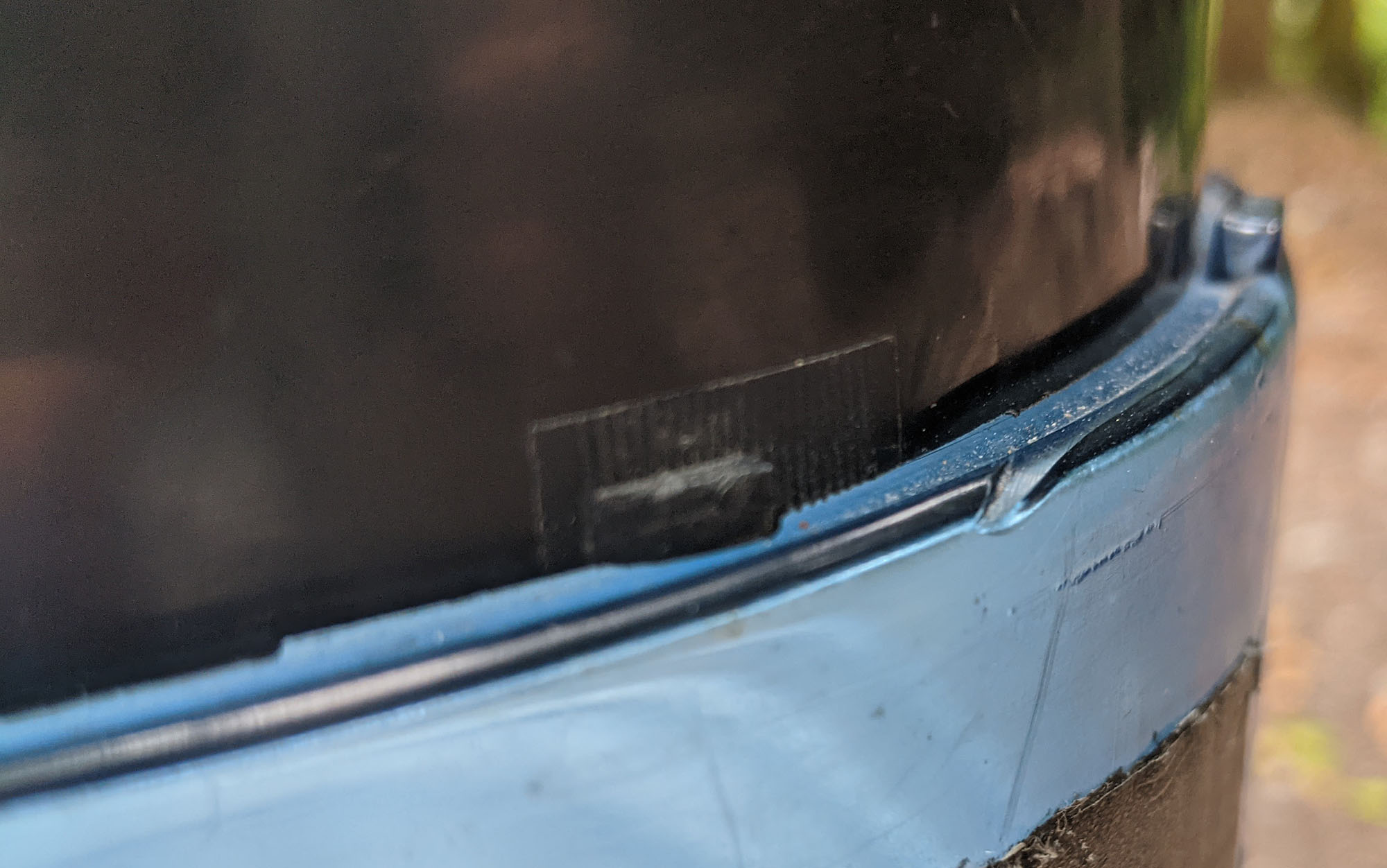
Even the largest size of the BearVault can be placed inside one of the best backpacking backpacks sideways. However, individuals using one of the best ultralight backpacks may find that they have to get creative with how they get it in or strap it on.
Best Lightweight: Grubcan Carbon 6.6
Best Lightweight
Grubcan Carbon 6.6
Key Features
- Available Size: 6.6 liters only
- Weight: 1.75 pounds
- Materials: Reclaimed carbon fiber and kevlar
- IGBC and WMI certified
- No tools required
- Functionality as a Seat: Poor
Pros
- Extremely tough for its weight
- First bear can certified by the WMI
- Partially made from reclaimed materials
Cons
- Tricky to open the first few times you use it
- Not accepted in all national parks
- Very expensive
If there is one downside to the BearVault it’s that bears have figured out how to get into it in the past. Most notoriously, a bear named Yellow-Yellow in the Adirondacks cracked the code and started targeting those canisters specifically. While BearVault made some changes to the mechanism in response to this, the opening mechanism is still fundamentally the same concept.
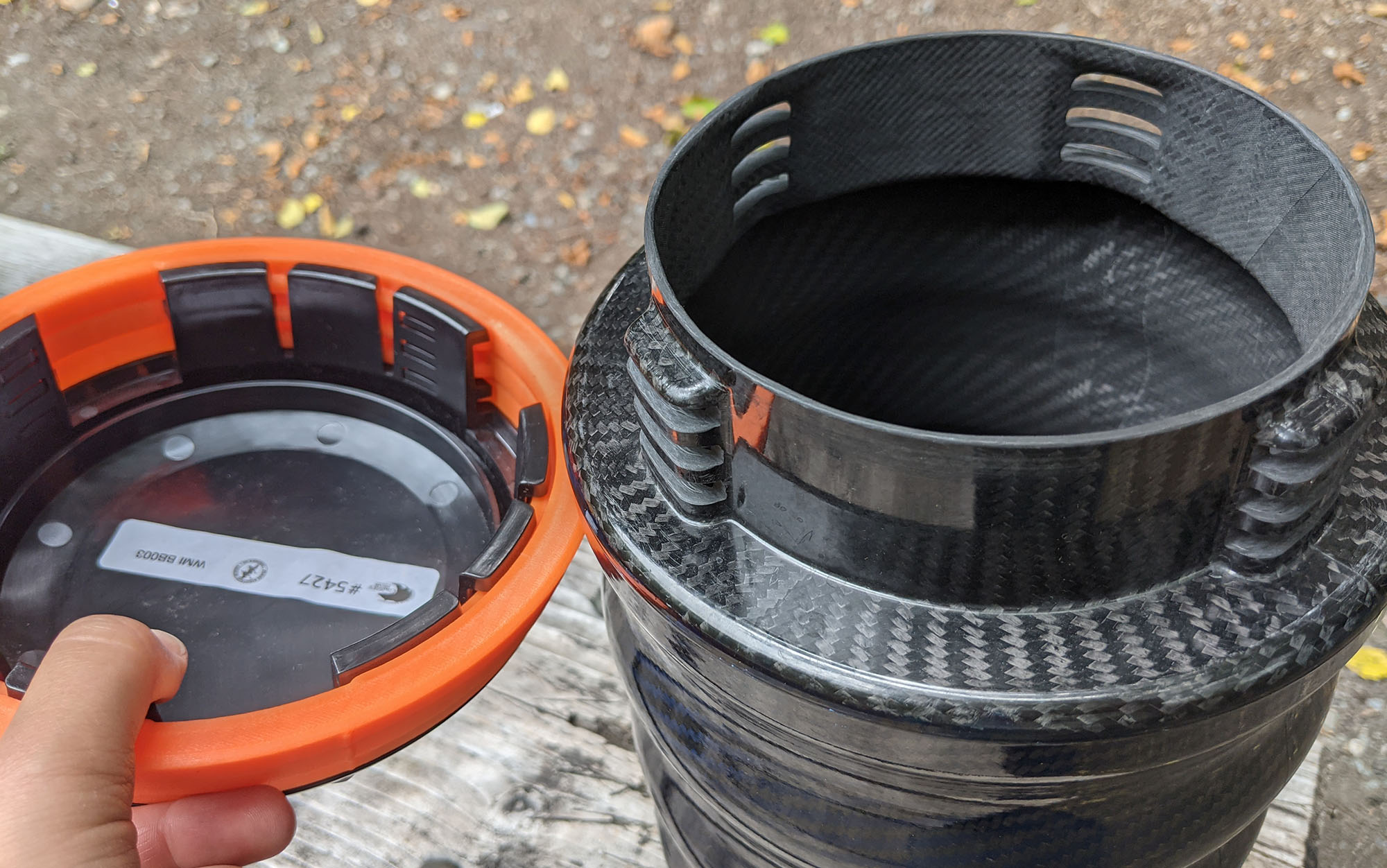
Grubcan is a newer bear canister that takes a different approach to toolless entry. There are three orange rings running around the middle section of the lid. To open and close the bear canister, the three tabs on the orange rings must be perfectly aligned with the arrow at the top of the lid and a faint notch on the canister body. To lock the canister, you simply spin the orange rings to different positions.
While I am impressed with how difficult this would be for a bear to figure out, it’s worth noting that it’s a bit tricky for people, too. The rings really must be perfectly lined up to both open and close the canister, and the lid lifted at the correct angle. In the privacy of my home with plenty of time and space to figure it out, I got there in the end. If I was cold and hungry in the field, I could see myself getting a little frustrated. But the potential for added security against bears (this design was created after numerous discussions with bear biologists) is real, so if you enjoy brain teaser puzzles this should go to the top of your list.
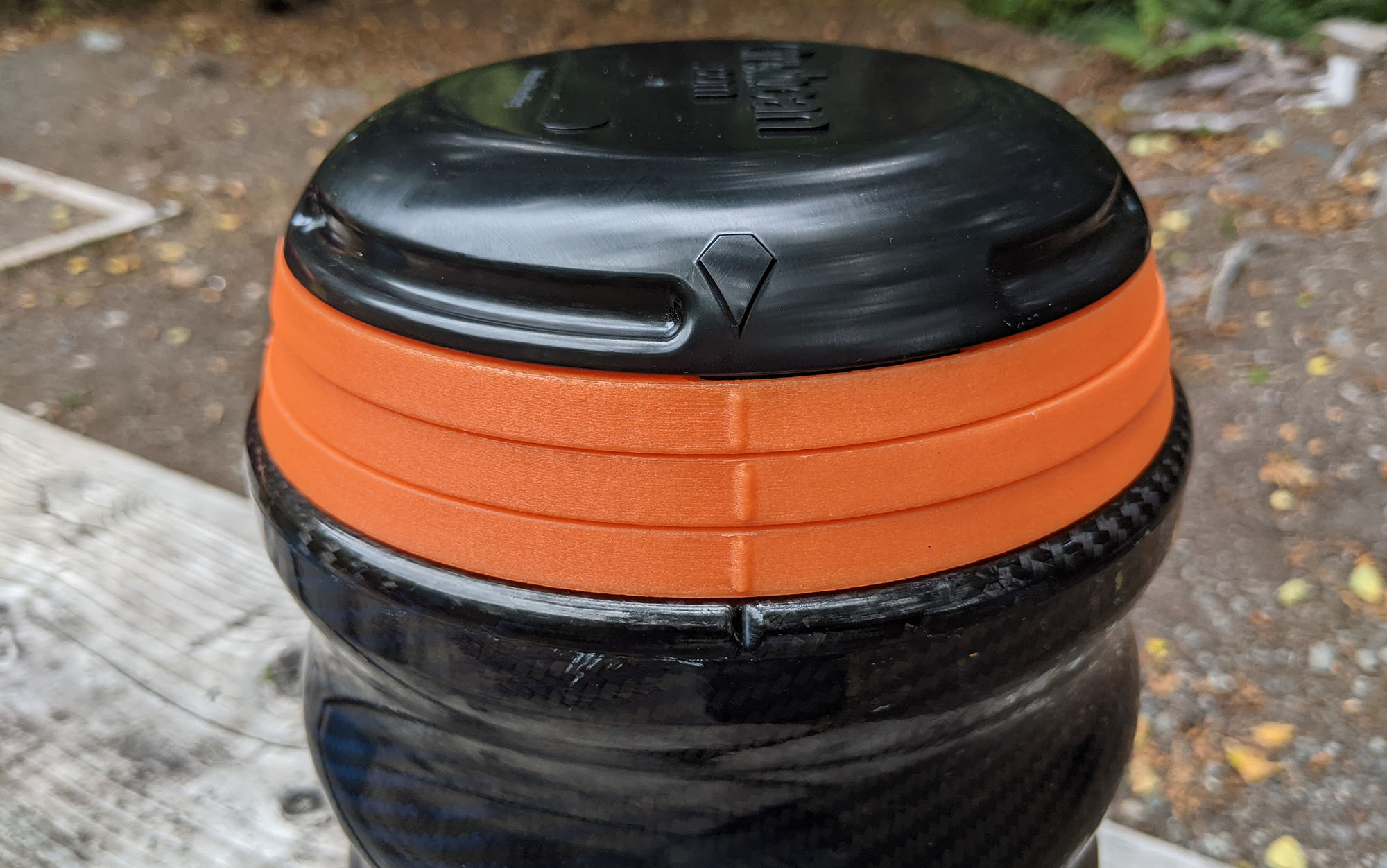
But that’s only part of what makes the Grubcan special. The other factor is its weight to strength ratio—fitting, since the founders have 20 years of experience making bulletproof panels for airplanes. It weighs the same as the smallest BearVault, but holds 1.6 liters more in capacity. Holly Jaleski, co-owner of the Grubcan, told me that not only did their Carbon 6.6 model pass the IGBC standard test, but that it also survived an unintended 15-minute encounter with Sam, a 1,000-pound Alaskan grizzly. (Sam is typically not used for testing at the IGBC center unless specifically requested.) Further, it is the first bear canister to pass the much newer Wildlife Management Institute (WMI) black bear test. This new program hopes to better understand what (if any) systematic differences there are in the ways that black bears and grizzly bears attempt to access food inside of bear canisters.
Best Ultralight: Ursack Major
Best Ultralight
Ursack Major
Key Features
- Available Sizes: 10.6 liters, 15 liters, 30 liters
- Weights: 7.6 ounces, 8.8 ounces, 10.9 ounces
- Materials: UHMWP
- IGBC certified
- Knot-tying skills required
- Functionality as a Seat: N/A
Pros
- Extremely lightweight
- Flexible fabric can be rolled up so that it takes up less space in your bag
- Pairs well with Opsaks for added smell-proof protection
Cons
- Must be able and willing to tie secure knots
- Not accepted in all national parks
The Ursack Major is all I use when I head into the backcountry, unless I’m headed to a national park with strict requirements about what is and is not allowed. The reason for that is simple: The smallest size weighs less than half a pound and I can fit five days of food for myself inside. Another perk is that the longer I hike, the less space it takes up in my pack.
While the other bear canisters on this list are made of unbelievably tough polycarbonates or carbon fiber blends, the Ursack Major is made from a material akin to Dyneema that is unbelievably tough. It’s tough enough to withstand the grizzlies at the Grizzly & Wolf Discovery Center during the IGBC test.

While the Ursack does not require any tools to open, there is a learning curve to using it properly. While the knots used to properly secure it are not especially complicated (Ursack recommends the double overhand knot), you do need to remember what you are doing when you are out in the field, with no internet reception to jog your memory. I’ve seen plenty of people simply tie their bag like a birthday present around a tree branch and call it good; that’s not going to cut it. If the hassle of dealing with an Ursack isn’t worth a pound of weight savings to you, then go with another option on this list.
Most Widely Accepted: Counter Assault Bear Keg
Most Widely Accepted
Counter Assault Bear Keg
Key Features
- Available Sizes: 11.7 liters
- Weights: 3.6 pounds
- Materials: Polymer blend
- IGBC certified
- Coin or other tool required
- Functionality as a Seat: Fair
Pros
- Accepted just about everywhere
- Classic design fits well into most traditional backpacks
- Bright yellow color is easy to spot
- Affordable
Cons
- Heavy
The Counter Assault Bear Keg, like the Garcia Backpacker’s Cache, is a classic design that has withstood the test of time and is accepted everywhere. Despite needing a tool to open (a simple quarter will do), it is one of the easiest bear canisters to operate on this list. The bright yellow makes it easy to spot in a variety of different terrains. It’s also quite affordable.
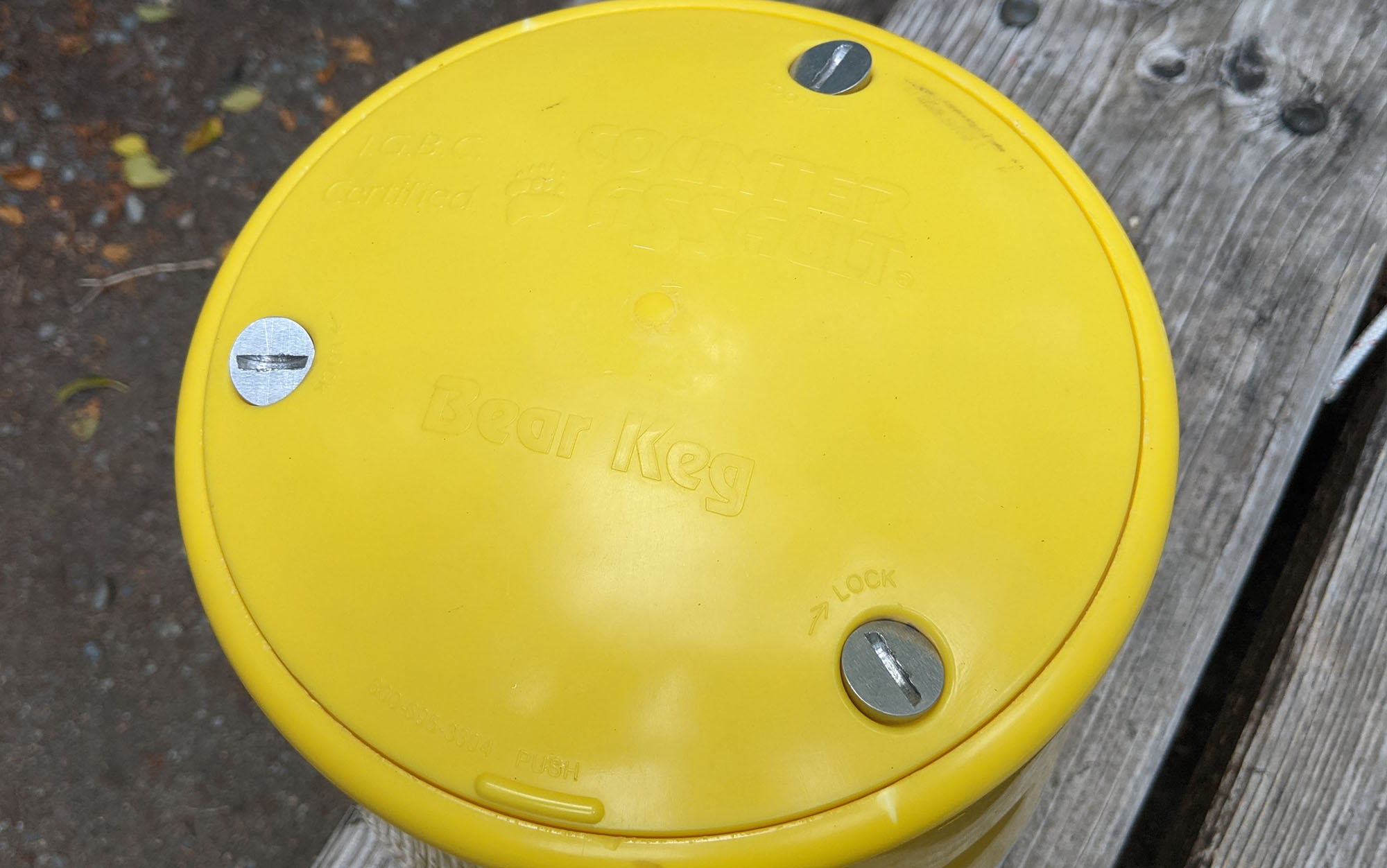
The catch is that it’s bloody heavy, the heaviest bear canister for its volume on this list. If you don’t mind a bit of extra weight, that might not be a limiting factor for you, but lightweight or ultralight backpackers will be happier with the BearVault in just about every environment except the old stomping grounds of Yellow-Yellow in the northeastern forests of the United States.
Best Seat: Frontiersman Insider Bear Safe
Best Seat
Frontiersman Insider Bear Safe
Key Features
- Available Size: 11.9 liters
- Weights: 3.5 pounds
- Materials: Polypropylene
- IGBC certified
- Coin or other tool required
- Functionality as a Seat: Good
Pros
- Simple opening and closing mechanism
- Designed to fit upright in backpacks, making it easier to fit gear around it
- Tall enough to use as a seat
- Affordable
Cons
- Heavy
- Not accepted in all national parks
Something people always say when they are trying to encourage you to carry a hard-sided bear canister is that you can use it as a seat. I’m 5-foot-5 with short legs and even I can’t use most of these things as seats. The exception to this is the Frontiersman Insider Bear Safe. This one really is tall enough to use as a seat. It’s even better if you can position it close to a rock wall or a tree to lean against.
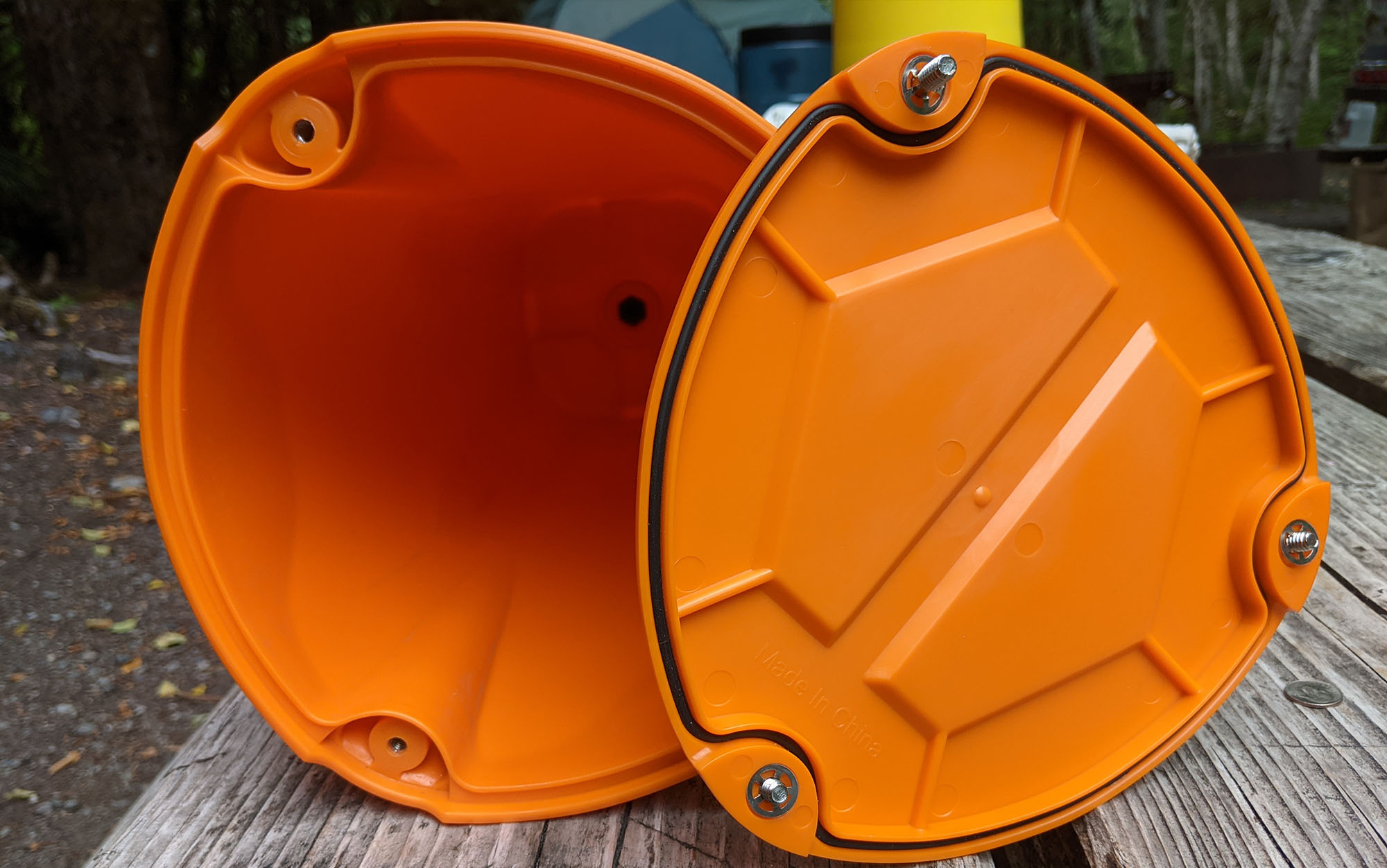
Part of this is because of the design of the bear canister. Whereas bear canisters are typically short and squat, the Frontiersman Insider Bear Safe is long, tapering at the bottom. The idea is to improve the weight distribution inside your backpack. Rather than having a heavy bear canister on the left-hand bottom pulling against your left shoulder uncomfortably, you place the Insider Bear Safe in the center of your pack and then distribute other items around it by weight. This helps to keep the heaviest weight (the bear can and your food) in the middle center of your pack, which is ideal for weight distribution. Entry-level backpackers who are working on getting their gear to fit comfortably in their pack will benefit from this out-of-the-box design, but most experienced backpackers will have a strategy in place already for distributing the weight when they are carrying a bear canister.
Things to Consider Before Buying the Best Bear Canister
Approval and Certification
Before you purchase a bear canister, check that it is approved for use in your land agency of choice. (If you spend a lot of time in the backcountry of California, check twice.) There are often very good reasons why only select bear canisters are approved in particular regions, and you can and will be fined for using a canister that isn’t approved. That is, if the bears don’t get your food first.
Ease of Opening
A bear canister that you don’t use properly isn’t worth purchasing. The ease of use between some of the heaviest bear canisters I looked at and their lightweight counterparts was often significant. Know yourself: If you aren’t up for learning and tying knots, don’t purchase an option that requires it. If you know that at the end of the day your motivation for fiddling with complicated closures is limited to non-existent, go with something that closes easily. While bears have in the past and will in the future break into properly secured bear canisters, the majority of incidents involve an open or improperly secured canister.
Weight
While there is a lot of hand-wringing among backpackers over the weight of bear canisters, this is one area where I’m going to encourage you to take less stock of it. Approval and correct use are the most important factors in your choice. Once those are squared away, then you can filter by weight and packed size.
Lifespan
Almost all of the best bear canisters are made from plastic, which degrades and weakens over time. Per Randy Gravatt, container testing coordinator at the IGBC, it’s best to replace bear canisters every five to seven years to ensure it’s truly capable of withstanding the raw power of a bear intent on breaking into it.
FAQs
Yes, bears can smell through bear canisters. If you want to make your food stash a bit harder for bears to locate, you can use an Opsack. This water-tight, odor-proof plastic bag can supplement your bear canister, but it should not replace it.
It is not necessary to bury your bear canister. While it does sometimes happen that a bear will roll a bear canister a long distance off while attempting to open it up, this is not the norm. Typically bears attempting to break into a bear canister will do it in the vicinity of where they found it.
Best practice is to place your bear canister 100 yards downwind from your tent. If available, placing your bear canister inside a thicket of trees can help prevent it from being rolled away too easily.
If you are unsure of what size bear canister you need, there are a few options. The first is to check manufacturers recommendations, as these will give you a sense of what other people are commonly able to do with it. If you can, purchase your bear canister well in advance of your trip and experiment with packing your food inside. Then, if it turns out to be too small, you’ll have enough time to return it. When in doubt, try to size up, as it’s important that all your food, trash, and scented items go into your bear canister that first night.
Scented toilet paper should go into your bear canister, but unscented toilet paper can be in your tent with you.
Why Trust Outdoor Life?
Since 1898, OL has been a leading authority in testing and reviewing hunting gear, fishing tackle, guns and shooting equipment, and much more. We have more than a century-long history of evaluating products, and we’re now bringing that expertise to online reviews. Our editors are experienced outdoorsmen and women, and most importantly, we’re trained journalists. We prioritize field testing and objective data when reviewing products. We conduct interviews with gear manufacturers and engineers as well as outdoor experts so that our readers have an understanding of how and why a product works—or doesn’t.
Advertising does not influence our gear reviews and it never will. While we always focus our coverage on standout products—because we want our readers to be aware of the latest and greatest gear—we also cover the flaws and quirks of any given product.
Final Thoughts on the Best Bear Canisters
If you spend time in bear country, having a plan to protect your food—and by extension, yourself—from bears is a must. While the bear hang was once considered an essential skill for backcountry travel, there is increasing awareness that this is a less effective strategy than land managers had hoped (the exception to this are the bear pole hangs set up by the park agencies for visitors).
Both black bears and grizzly bears (although not polar bears) can climb trees. Successful bear hangs need to be high enough off the ground and far enough out from the trunk that a bear can’t jump over to it. Not only are there plenty of places that don’t have trees with limbs high/close enough, long enough, or strong enough to make this work, there are even bear habitats that barely have trees at all. Trying to make a bear hang work in these environments is asking for a bear to break into your food. It’s worth the investment (and the weight) to have a great bear canister. Here are our top picks:
- Best Overall: BearVault
- Best Lightweight: Grubcan Carbon 6.6
- Best Ultralight: Ursack Major
- Most Widely Accepted: Counter Assault Bear Keg
- Best Seat: Frontiersman Insider Bear Safe
